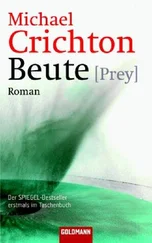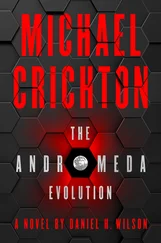Michael Crichton - The Andromeda Strain
Здесь есть возможность читать онлайн «Michael Crichton - The Andromeda Strain» весь текст электронной книги совершенно бесплатно (целиком полную версию без сокращений). В некоторых случаях можно слушать аудио, скачать через торрент в формате fb2 и присутствует краткое содержание. Жанр: Детская проза, на английском языке. Описание произведения, (предисловие) а так же отзывы посетителей доступны на портале библиотеки ЛибКат.
- Название:The Andromeda Strain
- Автор:
- Жанр:
- Год:неизвестен
- ISBN:нет данных
- Рейтинг книги:5 / 5. Голосов: 1
-
Избранное:Добавить в избранное
- Отзывы:
-
Ваша оценка:
- 100
- 1
- 2
- 3
- 4
- 5
The Andromeda Strain: краткое содержание, описание и аннотация
Предлагаем к чтению аннотацию, описание, краткое содержание или предисловие (зависит от того, что написал сам автор книги «The Andromeda Strain»). Если вы не нашли необходимую информацию о книге — напишите в комментариях, мы постараемся отыскать её.
The Andromeda Strain — читать онлайн бесплатно полную книгу (весь текст) целиком
Ниже представлен текст книги, разбитый по страницам. Система сохранения места последней прочитанной страницы, позволяет с удобством читать онлайн бесплатно книгу «The Andromeda Strain», без необходимости каждый раз заново искать на чём Вы остановились. Поставьте закладку, и сможете в любой момент перейти на страницу, на которой закончили чтение.
Интервал:
Закладка:
Again, Polton had a simple analogy. "Let us say you cut an automobile in half down the middle. In that case, you could guess the complete, 'whole' structure. But if you cut a very thin slice from the automobile, and if you cut it on a strange angle, it could be more difficult. In your slice, you might have only a bit of bumper, and rubber tire, and glass. From such a slice, it would be hard to guess the shape and function of the full structure."
Stone was aware of all the drawbacks as he fitted the metal button into the EM, sealed it shut, and started the vacuum pump. He knew the drawbacks and he ignored them, because he had no choice. Limited as it was, the electron microscope was their only available high-power tool.
He turned down the room lights and clicked on the beam. He adjusted several dials to focus the beam. In a moment, the image came into focus, green and black on the screen.
It was incredible.
Jeremy Stone found himself staring at a single unit of the organism. It was a perfect, six-sided hexagon, and it interlocked with other hexagons on each side. The interior of the hexagon was divided into wedges, each meeting at the precise center of the structure. The overall appearance was accurate, with a kind of mathematical precision he did not associate with life on earth.
It looked like a crystal.
He smiled: Leavitt would be pleased. Leavitt liked spectacular, mind-stretching things. Leavitt had also frequently considered the possibility that life might be based upon crystals of some kind, that it might be ordered in some regular pattern.
He decided to call Leavitt in.
[graphic of EM crystal pattern] Caption: (Early sketch by Jeremy Stone of hexagonal Andromeda configuration. Photo courtesy Project Wildfire.)
As soon as he arrived, Leavitt said, "Well, there's our answer."
"Answer to what?"
"To how this organism functions. I've seen the results of spectrometry and amino-acid analysis."
"And?"
"The organism is made of hydrogen, carbon, oxygen, and nitrogen. But it has no amino acids at all. None. Which means that it has no proteins as we know them, and no enzymes. I was wondering how it could survive without protein-based organization. Now I know."
"The crystalline structure."
"Looks like it," Leavitt said, peering at the screen. "In three dimensions, it's probably a hexagonal slab, like a piece of tile. Eight-sided, with each face a hexagon. And on the inside, those wedge-shaped compartments leading to the center."
"They would serve to separate biochemical functions quite well."
"Yes," Leavitt said. He frowned.
"Something the matter?"
Leavitt was thinking, remembering something he had forgotten. A dream, about a house and a city. He thought for a moment and it began to come back to him. A house and a city. The way the house worked alone, and the way it worked in a city.
It all came back.
"You know," he said, "it's interesting, the way this one unit interlocks with the others around it."
"You're wondering if we're seeing part of a higher organism?"
"Exactly. Is this unit self-sufficient, like a bacterium, or is it just a block from a larger organ, or a larger organism? After all, if you saw a single liver cell, could you guess what kind of an organ it came from? No. And what good would one brain cell be without the rest of the brain?"
Stone stared at the screen for a long time. "A rather unusual pair of analogies. Because the liver can regenerate, can grow back, but the brain cannot."
Leavitt smiled. "The Messenger Theory."
"One wonders," Stone said.
The Messenger Theory had come from John R. Samuels, a communications engineer. Speaking before the Fifth Annual Conference on Astronautics and Communication, he had reviewed some theories about the way in which an alien culture might choose to contact other cultures. He argued that the most advanced concepts in communications in earth technology were inadequate, and that advanced cultures would find better methods.
"Let us say a culture wishes to scan the universe," he said. "Let us say they wish to have a sort of 'coming-out party' on a galactic scale- to formally announce their existence. They wish to spew out information, clues to their existence, in every direction. What is the best way to do this? Radio? Hardly- radio is too slow, too expensive, and it decays too rapidly. Strong signals weaken within a few billion miles. TV is even worse. Light rays are fantastically expensive to generate. Even if one learned a way to detonate whole stars, to explode a sun as a kind of signal, it would be costly.
"Besides expense, all these methods suffer the traditional drawback to any radiation, namely decreasing strength with distance. A light bulb may be unbearably bright at ten feet; it may be powerful at a thousand feet; it may be visible at ten miles. But at a million miles, it is completely obscure, because radiant energy decreases according to the fourth power of the radius. A simple, unbeatable law of physics.
"So you do not use physics to carry your signal. You use biology. You create a communications system that does not diminish with distance, but rather remains as powerful a million miles away as it was at the source.
"In short, you devise an organism to carry your message. The organism would be self-replicating, cheap, and could be produced in fantastic numbers. For a few dollars, you could produce trillions of them, and send them off in all directions into space. They would be tough, hardy bugs, able to withstand the rigors of space, and they would grow and duplicate and divide. Within a few years, there would be countless numbers of these in the galaxy, speeding in all directions, waiting to contact life.
"And when they did? Each single organism would carry the potential to develop into a full organ, or a full organism.
"They would, upon contacting life, begin to grow into a complete communicating mechanism. It is like spewing out a billion brain cells, each capable of regrowing a complete brain under the proper circumstances. The newly grown brain would then speak to the new culture' informing it of the presence of the other, and announcing ways in which contact might be made."
Samuels's theory of the Messenger Bug was considered amusing by practical scientists, but it could not be discounted now.
"Do you suppose," Stone said, "that it is already developing into some kind of organ of communication?"
"Perhaps the cultures will tell us more," Leavitt said.
"Or X-ray crystallography," Stone said. "I'll order it now."
Level V had facilities for X-ray crystallography, though there had been much heated discussion during Wildfire planning as to whether such facilities were necessary. X-ray crystallography represented the most advanced, complex, and expensive method of structural analysis in modern biology. It was a little like electron microscopy, but one step further along the line. It was more sensitive, and could probe deeper- but only at great cost in terms of time, equipment, and personnel.
The biologist R. A. Janek has said that increasing vision is "increasingly expensive." He meant by this that any machine to enable men to see finer or fainter details increased in cost faster than it increased in resolving power. This hard fact of research was discovered first by the astronomers, who learned painfully that construction of a two-hundred-inch telescope mirror was far more difficult and expensive than construction of a one-hundred-inch mirror.
In biology this was equally true. A light microscope, for example, was a small device easily carried by a technician in one hand. It could outline a cell, and for this ability a scientist paid about $1,000.
An electron microscope could outline small structures within the cell. The EM was a large console and cost up to $100,000.
Читать дальшеИнтервал:
Закладка:
Похожие книги на «The Andromeda Strain»
Представляем Вашему вниманию похожие книги на «The Andromeda Strain» списком для выбора. Мы отобрали схожую по названию и смыслу литературу в надежде предоставить читателям больше вариантов отыскать новые, интересные, ещё непрочитанные произведения.
Обсуждение, отзывы о книге «The Andromeda Strain» и просто собственные мнения читателей. Оставьте ваши комментарии, напишите, что Вы думаете о произведении, его смысле или главных героях. Укажите что конкретно понравилось, а что нет, и почему Вы так считаете.









